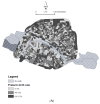Using a Clustering Approach to Investigate Socio-Environmental Inequality in Preterm Birth-A Study Conducted at Fine Spatial Scale in Paris (France)
- PMID: 30200368
- PMCID: PMC6163167
- DOI: 10.3390/ijerph15091895
Using a Clustering Approach to Investigate Socio-Environmental Inequality in Preterm Birth-A Study Conducted at Fine Spatial Scale in Paris (France)
Abstract
Background & Objectives: Today, to support public policies aiming to tackle environmental and health inequality, identification and monitoring of the spatial pattern of adverse birth outcomes are crucial. Spatial identification of the more vulnerable population to air pollution may orient health interventions. In this context, the objective of this study is to investigate the geographical distribution of the risk of preterm birth (PTB, gestational age ≤36 weeks) at the census block level in in city of Paris, France. We also aimed to assess the implication of neighborhood characteristics including air pollution and socio-economic deprivation. Material & Methods: Newborn health data are available from the first birth certificate registered by the Maternal and Child Care department of Paris. All PTB from January 2008 to December 2011 were geocoded at the mother residential census block. Each census block was assigned a socioeconomic deprivation level and annual average ambient concentrations of NO₂. A spatial clustering approach was used to investigate the spatial distribution of PTB. Results: Our results highlight that PTB is non-randomly spatially distributed, with a cluster of high risk in the northeastern area of Paris (RR = 1.15; p = 0.06). After adjustment for socio-economic deprivation and NO₂ concentrations, this cluster becomes not statistically significant or shifts suggesting that these characteristics explain the spatial distribution of PTB; further, their combination shows an interaction in comparison with SES or NO₂ levels alone. Conclusions: Our results may inform the decision makers about the areas where public health efforts should be strengthened to tackle the risk of PTB and to choose the most appropriate and specific community-oriented health interventions.
Keywords: air pollution; neighborhood deprivation index; preterm birth; spatial approach.
Conflict of interest statement
The authors declare they have no actual or potential competing financial interests.
Figures



References
-
- Mathews T.J., MacDorman M.F. Infant mortality statistics from the 2005 period linked birth/infant death data set. Natl. Vital Stat. Rep. 2008;57:1–32. - PubMed
Publication types
MeSH terms
Substances
LinkOut - more resources
Full Text Sources
Other Literature Sources
Medical

